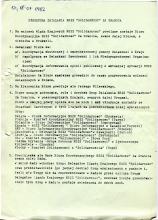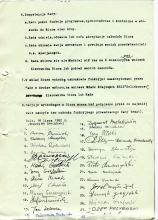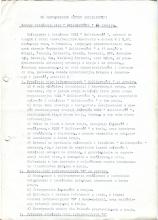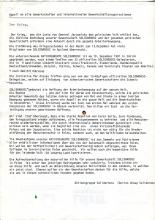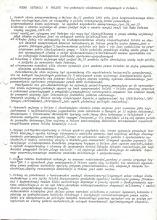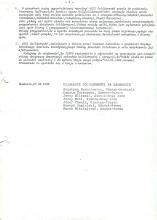Anyone who goes back to the last years of the communist regime, thinking about the phenomenon of “Solidarity” of invigorating impulses that brought Polish pope choice. Few, however, equally serious about another phenomenon of the 70s and 80s in Poland. As for the second circuit called, to distinguish it from the first, subject to state censorship, an independent publishing movement, the scale of which is still, even for historians and bibliographers working on this theme, difficult to grasp.
About the Polish, and only the Polish phenomenon Jakub Karpinski wrote: “The existence of underground magazines and is one of the greatest successes of the opposition in the state of war and beyond. Magazines significantly broke the monopoly of the authorities for information. Restoration of this monopoly was one of the objectives of martial law (…), and this goal has not been realized. ”
14 years of existence independent of the publishing cycle, a few hundred underground publications, approx. 6 thousand. journals and more than 7 thousand. published books and pamphlets, hundreds of postage stamps underground, hundreds of thousands of leaflets, posters, prints greeting. There are thousands of distributors, printers, editors, publishers, readers finally. This is a huge national organizations – businesses and tiny single workshop. This book, without which it is difficult to imagine Polish culture, essays and poetry of Milosz, prose and “Diaries” Gombrowicz and Herling-Czapski essays, novels Konwicki and Kazimierz Brandys. These are people who have next to their normal profession – a doctor, a worker, a miner, teacher, student, student nurse, a lawyer for many years led a second life – editor, underground printer, a distributor who haul shipments of paper and smuggled from the West materials and printing equipment .
pioneers
In the years 1944-1953, under communist rule, in addition to hundreds of leaflets published underground newspapers, pamphlets and books. Liquidation of armed resistance, which occurred in the early 50s led to a liquidation of the independent press and publications. Not stimulated initiatives in this field events 56 years and so. October thaw, although it is worth mentioning that a copy of Khrushchev’s secret speech delivered at the Twentieth Congress of the CPSU, as early as a few days after the communication of the highest authorities of the Communist Party could be bought at the bazaar Różyckiego Warsaw.
Attempts to issue independent prints, taken in subsequent years, there were sporadic and quickly disposed of by the Security Service. One of the first known, was Antoni Zambrowski, the son of one of the secretaries of the Central Committee and later an opposition activist. He organized by rewriting samizdat (on the machine) special bulletins Polish Press Agency, containing materials available only to members of the party and state authorities. Another, Jan Peter Jarosz, who in 1967, at age 14 with his colleagues called to live an illegal organization Union of Free Poles and small printing house – toys printed leaflets against the elections to the Sejm, and a year later against the aggressive forces of Czechoslovakia. The year 1968 was indeed unique. Rise of the students in March, primarily at the University of Warsaw, has resulted in dozens of leaflets, often prescribed by hand. Flyers that arose spontaneously, there were also a response to the aggression against Czechoslovakia. The most interesting, because of the technique that was first used, it was leaflet prepared by the NRA later collaborator, who died a few years ago Bogusława Blajfer. In the role of multiplier applied the first time … wringer washing machine rotor Frances popular and it was an epoch-making invention, and good old machine will not be used again for printing was illegal publications.
Sample, which could be successful, was taken in the late 60’s and 70 initiative of a secret organization “Movement”, which occurred before the arrest, on stolen duplicators she published six issues of the magazine “Bulletin” and several issues of “Handbook”. Another case of censorship of publications issued outside, took place in 1973, when a young writer Janusz Anderman at the photocopier released a book of poems by the censors rejected the poet Julian Kornhauser, belonging to the tribe of new wave, which soon almost entirely due to the restrictions of censorship was published samizdat in publications. Another poet of this generation, a future member of the NRA Stanislaw Barańczak, the first underground volume (rewritten on the machine) “artificial respiration” published in 1974.
However, when in September 1976 issued appeared uncensored, and with the use of the multiplier, a letter with the significant title “On the threshold” (one of the editors was Former Justice Minister), there has been no breakthrough yet. Avalanche started KOR only two letters that appeared at the same time, because at the end of September 1976, the “Communication” KOR (edited by Anka Kowalska, Janusz Przewłocki and Andrzej Jastrzebski) and the “Bulletin” (edited for by Seweryn Blumsztajn and Joanna Szczęsna) and formed in January 1977 “Record” (founded by Jack Bocheńskiego among others), a literary magazine, the editors and authors have dared to reveal their names. All of these writings, initially prescribed on the machine, like a real samizdat, and then printed on duplicators had what then there was “On the threshold.” They were not anonymous, which is not condemned them to circulate in a closed circle of insiders. They were behind him, arose after the workers ‘protests of June 1976 the Workers’ Defence Committee, whose members names, addresses and telephone proclaimed in “Communication”. Publicity allowed to expand the circle of colleagues, readers and individuals to support independent publishing workflow. It’s no wonder that soon the majority of underground magazines gave the names and addresses of the editors, and many authors no longer hide under pseudonyms, signing their names texts. The same was true during the eighteen-month period, the legal existence of the “Solidarity”, between September 1980 and December 13, 1981, when there was a crop of independent press and publications, especially trade unions. Martial law, which as one of the main objectives set itself, the liquidation of an independent circulation of ideas and information, the situation has changed dramatically. Repression which participants met the underground publishing movement, forced them to descend to a real conspiracy, and thus forced anonymity. Completely underground now descended not only printers, but also all the editors and organizational base papers and publications. Also writers published in underground newspapers rarely disclose their names. But the authors of literary texts still often wrote under the name.
From June to June
14 years of existence of the independent publishing movement can be divided into several phases. First, the period from 1976 to 1980, when both structures were as opposition and independent structure of the publishing cycle. The breakthrough was the year 1977. The resulting the Movement for the Defence of Human Rights (ROPCiO) started publishing his magazine “Opinion”, then appeared in “The Voice”, the monthly socio-political faction of the NRA, referring to the tradition of national youth magazine “Bratniak” biweekly “worker “who sponsored the formation of the seeds of free trade unions in Poland, and finally another after the” Legacy “literary magazine” Puls “, issued by young writers and publishing as opposed to quarterly” Record “texts written specifically for the second circuit. In 1977, the magazine was founded in Lublin young Catholics “Meetings”, written letters student, peasant. 1977, is also the date of appearance of the first the underground press Publishing, Independent Publishing House NEW. Next year is another writing and publishing, arising mainly in Warsaw, but also in other cities like Krakow, Poznan, and even villages, as Zbrosza large, where the local Peasant Self-Defense Committee looked up two independent newspapers (in ks.Czesława Sadlowski) .
The breakthrough was August 1980. During August strikes at the Gdańsk Shipyard appeared “Solidarity Strike Information Bulletin,” which not only gave the name of the emerging free trade unions, but also became the title of a model for the whole lifetime of publishing legal “Solidarity”. After the signing of the August Agreements of this nature writings appeared like mushrooms after rain. One of the creators of the “Bulletin” Belinsky said Konrad (“tissue paper”, Rzeczpospolita, June 2003.): “One of the first steps in each plant once the connection was to create a free newsletter”. It is estimated that in the period 1976-1980 were in all about 100 journals and 35 publications published about 300 books and pamphlets. In just half a year of legal operation of free trade unions, called “Carnival of Solidarity” ok.160 already worked publications that have published without the permission of censorship over 2500 items. At the same time, you can record up to 3,200 journal titles. Much of it came out on the equipment capital, in terms half legal, although not subject to censorship.
Most of them have ceased to exist with the delegitimizing of “Solidarity” and the destruction or confiscation of printing equipment and arrests printers, editors and publishers after December 13, 1981. However, the liquidation of the independent publishing movement failed. Already in December because, in addition to leaflets, the first underground magazine. Warsaw “Messages” (continued “News Day”, appearing before December 13, 1981), and having the nature of the news agency “Information Solidarity” Wrocław “From Day to Day”, and in January next, including the most important writings of this period as the “Weekly War “,” KOS “or” Will “, and in February the largest underground magazine” Solidarity “,” Weekly Mazowsze “. They were the writings of information – journalism, and such was the highest, but soon developed some other, as literary magazine “Call” or devoted to the visual arts “Sketches”. Also created another underground publications, such as CDN and specializing in the publication of fiction daybreak. The resulting record, finally, underground annex, publishing cassettes, began implementation and replication of underground films, independent radio moved “S”, and then also an underground cable. They seemed everyone. Any organization, political option, representatives of almost all occupations, single people. Ba, writing and publishing underground there are even in detention centers where the arrested activists placed “Solidarity”. Formed part of the publication there transcribed by hand, but sometimes used primitive techniques duplicator. In one of the detention centers operated even underground radio.
The underground was also his bestsellers, such were the history books by Norman Davies, whether written specifically for publishing samizdat “Konspira ‘report on the leaders of the underground” Solidarity “, a collection of interviews with leading Polish Stalinists” They “Teresa Torańskiej, children’s book” Thanksgiving school Polish People’s Republic, “Maryna Miklaszewska or comic” Solidarity: the first 500 days “.
The diversity of writings was even greater. It was all the information from the press, the political journalism, historical or social, literary magazines, economic, dedicated to the art, science, philosophy. They were satirical writings were student and children, were letters for teachers and doctors, there were many writings devoted to the socialist camp, the former church and anti-Church writings. And the most – the anti-Communist.
Printers small and larger
Right at the beginning of martial law in the outgoing official, and designed for preschoolers, writing “Teddy Bear” appeared unusual insert. It was called “Little printer”, and presented a way to construct a small print shop with a spool of thread. Most pleased that adults who met in the editorial joke, which is not noticed censorship and parted number on the trunk. This anecdote illustrates not only the universality of the phenomenon, but also reflects the different characteristic. It’s about something that distinguished Polish underground publications, publications of this type in other countries of the Soviet bloc. It is about the use of technology, even the most primitive, yet technology. Because the Poles printed on everything, in the words of one of the underground printers for just anything and often sloppy. But still printed, what distinguishes the phenomenon of Polish Russian samizdat.
Using techniques led to the greatest extent that independent publications and writings transformed over time into a powerful, secret company, numbering several hundred people, with technical and organizational necessary for existence. And so: they were accountants, caterers, printers, organizers distribution and marketers, editors, authors, translators (some permanently excused for underground publishers), visual artists performing covers projects were necessary premises for warehouses, for equipment, for underground printing, distribution boxes were needed, they were the driver and also cars, sometimes specially purchased for independent companies, as well as part of the premises, which were sometimes rented, sometimes fictitiously, sometimes owners do not really have a clue what’s going on in their apartment, as well as workshops and professionals repair equipment, producing it or producing some materials necessary for printing, for example. chemists, preparing light-sensitive emulsion for screen printing printers. In a state of war, when many opposition activists were threatened with internment or imprisonment were also needed for hiding premises, premises, and therefore also the organizers and those seeking a grid such facilities (for security reasons they had to be quite often vary). Needed people to flip hardware and émigré publications from abroad, as well as the shifting of materials and illegal publications abroad were needed representatives – coordinators, dealing with foreign aid, and working outside the country were also needed by those who coordinated the country such centers in on behalf of the publishers or editors.
Ingenuity and entrepreneurship organizers of illegal printing is not limited to the improvement of equipment and technology. One of the more widely used methods of printing was illegal in the state printing, ie tzw.dojściach (so gave almost all of Gombrowicz’s Krzysztof Wyszkowski l.70). In this way, the publications were obtained do not differ from the quality and appearance of the officially issued. Got to the point that at the end of the 80’s underground publications can be purchased almost without fear before the universities, not to mention the fact that some of the students at universities wore special paper so as to protrude from the pocket. To impress colleagues, especially colleagues.
Perpetrators aware, though unknown
In Poland, ruled by a team of Play, economic policy and pressure from the West on human rights, forced to tolerate opposition, and thus independent publishers. The 70’s were so kind of fun cat with a mouse, the repression of the underground activists were limited mainly to harass revisions and closing for 48 hours and the confiscation of equipment and publications. Treated more leniently underground publishers during the legal action “Solidarity”. Only after the imposition of martial law, anyone who began issuing illegal press and books, he had to reckon with the real repression. Internment, long prison sentences, colleges and high fines were on the agenda. There were beatings, kidnappings, and even … murder, organized so that the perpetrators were aware, though unknown.
But also experienced more subtle methods, to discredit opposition activists or organizations which were related to the underground magazine. The flagship way they were. so. fakes. First we note in just a month after the formation of the first uncensored writings. Here is the date of October 25, 1976 released version 3 Esbeck issue of “Communication KOR” altered to provide a false light in the activities of this organization defending workers. False apogee in the years eighties. Especially often been falsified TKK authority “of Solidarity,” but it was getting too different. It is interesting by the security establishment’s own writings from scratch, it was a monthly “Without diktat”, led by a member of the authorities, “S”, and at the same time (which he later revealed) SB officer invested in the structures of the Union, Eloi Naszkowskiego. Tone of the articles, however, occurred to the reader to suspect that this publication is for someone else. Another feature of fakes meant that they did not apply the desired effect. Publishing secret police were often issued … too well. For a good paper, with clearly printed, for someone who knew the problems underground hardware, paper, quality prints, it was a signal to such publisher to look more closely.
Konspira
John Waltz, editor of the underground “Information Bulletin” and printer in Independent Publishing House v, published just before August 1980 report from working in an underground printing house: “Call Zenek and says that he wants to see me on Monday at 11. If anyone thought that I have yet to meet three days time – makes a mistake. And that’s just the point. The Monday meeting was informed about the 11 sergeant from service phone hacking. Do you also learned who I meet, do not know. Zenk I recognize his voice. In contrast to the sergeant I know I always have to subtract two, so we have an appointment on Saturday at 9, cafe “Wicker” – the place is always the same. So I have to pack a bag with all the necessary equipment for the independent printer (…) and for the next week off from life. Relevant to withdraw any appointments by phone, or better still recall the sergeant that I made an appointment with someone on Monday at eleven. Contact Sergeant easy: just call someone from the friends – Kuroń, Michnik or Romaszewski and say that (…) can try to fall on Monday … ”
In the early years there were few independent publishers in the business of real conspiracy. Only martial law, exacerbating repression and introducing permanent control almost all aspects of social life, forced to tap into proven solutions by their predecessors. There have nicknames, flower pots in the windows, which warned that the property is burnt, there were all sorts of passwords and codes reconnaissance. But as in any field, there also was a mess, experienced mistakes or situations native of cabaret. Once, in a major scientific institution in the presence of a few astonished professor spoke by phone with another lady professor – but he has to be truncated tail! – Demanded. The idea was to ensure safety in the clandestine meeting with a well-known journalist Stefan Bratkowski. A request that the dog had cut off the tail, meant bringing the editor without accompanying constantly “tail” undercover.
Another way of upholding the authors, gaining the courage of publications under the name, resembled ordering straight from the fairy folk. As for the habit of putting on many published with the name of the author texts, notes: issued without the knowledge and consent of the author. I have not heard that this clause was saved someone from repression, but kept her persistently. Gave rise to funny situations. The well-known British historian Norman Davies recalls how it was paid to him with a request to give its consent to one of the underground publications on the issue of one of his books – without the knowledge and consent of the author. British analytical mind had pause to consider the paradox of this formula, in the end: to give permission to publish the book without their knowledge or consent. Probably the only one who opposed the rule was a poet and writer Antoni Pawlak, who in his publications he wrote, “has been issued with the knowledge and permission of the author.”
People, that is not Baccalaureate …
Stephen Rudka, author of a monograph on second circuit Wroclaw press wrote that the editor of the underground was left out of the case. One has to admit that he was right, although they were in the underground for years 70 and professionals. Motives guided by those who started to edit, print, and distribute independent publications were various. From patriotic or political (to hit Communion), the … love of books (as in the case of the well-known bookseller Czeslaw Apiecionka or editor of “Information Bulletin” KOR, Przemyslaw Cieslak).
Was completely different after August, and the situation repeated itself after December 13, 81. It was a time of true popular uprising, and mace editorial and most also wore a backpack printing each, just to know how to read and write and had the desire. In the PRL was said: “I do not baccalaureate, but sincere desire, will make you an officer.” In this way, makes fun of us from the communist agendas, where in accordance with the recommendations of Lenin cleaner was to rule the country. With governments did not work out well. But in some parts of Lenin’s saying true in Polish samizdat, where the housekeeper, nurse, worker, farmer, student, student, lawyer, doctor, plastic, steel worker, fisherman or sailor from one day to become an editor, printer, distributor of, the boss publishing and the chief of the underground magazine.
Jan Strękowski

